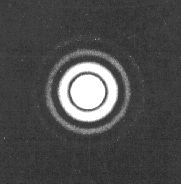Airy disk
An Airy disk is the central bright circular region of the pattern produced by light diffracted when passing through a small circular aperture. The central disk is surrounded by less intense concentric rings, so light intensity takes local maxima and mimina while it decreases away from the center.
The size of an Airy disk depends on the WaveLength of the light and the size of the aperture. (It also depends on the distance from the aperture, but in this context it is usually measured at the focal plane of a lens). Thus, if the aperture is the objective of a Fluorescence Microscope with Numerical Aperture NA, the radius r of the Airy disk (the distance between the central maximum and the first minimum) at the focal plane is
$$ r\ =\ 0.61\ \frac{\lambda} {\text NA} $$
Using dimensionless coordinates, the radius of an Airy Disk is 3.83 Optical Units. About 84% of the total light intensity is in the central disk, the remainder 16 % is distributed in the concentric rings.

An Airy disk is the projected image of a single point object in a microscope, so you can see it as the 'brick' component of the recorded image. It is the 'blur' of a single point source: adding all the blurs, you obtain a blurred image. See Image Formation.
Due to the nature of a Fluorescence Microscope the light intensity varies also along the optical axis Z in a similar way, so the 3D image of a single point is something like a 3D-Airy disk: a Point Spread Function.
In Confocal Microscopes, the Airy Disk is sometimes used as a unit to report the Pinhole Radius.
